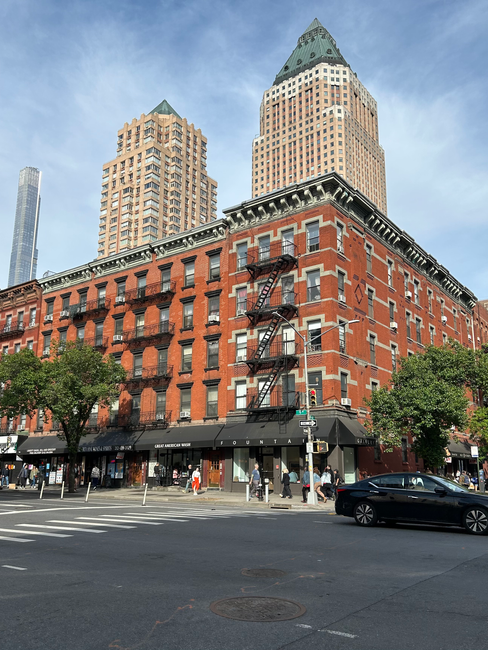Internship or Traineeship in the United States: Complete Step by Step Guide
- Megan Vlemmix
- 23 okt
- 7 minuten om te lezen
Do you, like me, dream of doing an internship or traineeship in the United States? It is not as impossible as it seems! I personally lived in New York for almost two years. First I did an internship of eight months, and after spending a few months in the Netherlands I returned for fourteen months for a traineeship. A dream came true, and now I want to help others achieve the same. That is why in this post I am sharing an honest and detailed step by step guide with all the information you need to arrange an internship or traineeship in the United States.
*In this post I am speaking purely from my own experience; any mentions of companies are not sponsored.
Arranging an Internship or Traineeship
Let’s start at the beginning. Arranging an internship or traineeship in the United States is more complex than doing so within Europe, because not all companies are willing to sponsor a foreign student or a recent graduate with a visa. Fortunately, there are organizations that can help. One of the most well-known and reliable is Stage Global. I personally arranged both my internship and later my traineeship through this company and I can recommend them to anyone.
Stage Global is a company that supports students and recent graduates in finding a suitable internship or traineeship in the United States and also assists with the entire process, which is very helpful. They help with things such as:
Finding a paid internship or traineeship
Arranging the mandatory J-1 visa
Guidance in preparing your CV and motivation letter
Support with housing, insurance, banking, and all practical matters involved
Without the help of this company, I don’t think I would have navigated the visa process so easily, and I probably wouldn’t have ended up at the companies where I completed my internship and traineeship. They do charge a fee for arranging all of this, but that seems completely reasonable to me and it was worth it 100 percent.
The term “recent graduate” can be interpreted broadly. I did my traineeship together with two fellow “recent graduates” aged 29 and 33. So it is never too late to apply!
How does it work? After registering with Stage Global, you have an intake interview where they discuss your wishes and expectations, and also ask if you have a preference for a city or state. Based on that, they help you prepare a suitable CV and motivation letter and select a few companies for you. If those companies interest you, they arrange an interview for you. You conduct the interview yourself, which works similarly to how it would in the Netherlands, usually with two or three rounds, after which the company makes a selection.
J-1 Visa: What You Need to Know
Once you have been accepted for an internship or traineeship, the visa process begins. There are quite a few steps, rules, and documents involved. One of the most important things to know is that for an internship or traineeship, you need a J-1 visa. This is a special exchange visa for students and recent graduates, which allows you to complete an internship or traineeship at a recognized company in the United States for a certain period of time.
It is important to know that you can apply for a J-1 visa a maximum of two times in your lifetime. So it’s worth thinking carefully about when to apply, to make the most of it.
With a J-1 visa, you can stay in the United States for the duration of your internship or traineeship program, with a maximum of twelve months for an internship and eighteen months for a traineeship. Often, you are allowed to stay up to thirty days after your program ends to travel, but during this period you are not allowed to work. This is called the “grace period.”
You cannot apply for a J-1 visa directly with the U.S. government on your own. You always need an official “sponsor.” This is a recognized organization that guides your application and ensures that you meet all the requirements. Stage Global works with such sponsors and handles this part for you. This is one of the main reasons to go through Stage Global, because finding a sponsor on your own can be very difficult.
Your sponsor will also prepare the DS-2019 form for you. This is an official document that confirms your acceptance into a recognized exchange program in the United States. Without this form, you cannot apply for a J-1 visa at the U.S. consulate in Amsterdam. The DS-2019 includes your personal information, the duration of your program, and the details of the company where you will be working.
Keep in mind that the entire visa application process takes time, so start early, ideally at least three to five months in advance.
Practical Matters Upon Arrival in the United States
Once you arrive in the U.S., the adventure truly begins. But before you can start your internship or traineeship, there are a few important things you need to arrange.
1. Social Security Number (SSN)
A Social Security Number is similar to a citizen service number and is required if you will be working or doing an internship in the U.S. You can only apply for it once you are in the country, at a local Social Security office. You can make an appointment through their official website.
To apply for an SSN, you will need your passport, visa, DS-2019 form, and a confirmation letter from your internship company. Processing usually takes a few weeks. In the meantime, you can typically start your internship or traineeship, but you won’t be able to receive your salary until the SSN is issued.
2. Opening a U.S. Bank Account
If you are receiving a stipend or salary, having a U.S. bank account is very convenient. You can easily open an account at Bank of America, Chase, or Wells Fargo. These banks accept international applicants, and you usually only need your passport, visa, and proof of U.S. address (for example, a rental contract).
You can only arrange this once you are in the U.S., as you must be physically present. Often, you can just walk into a branch without an appointment.
3. Getting a U.S. Phone Number
Having a U.S. phone number is highly recommended. It makes it easier to stay in contact with your company (WhatsApp is not widely used in the U.S.) and is necessary for practical matters such as opening a bank account or activating certain apps and accounts that require a U.S. number.
You can arrange this before departure with a J-sim subscription. They send you a SIM card at home, and you receive a U.S. phone number that is active as soon as you land. I had a subscription with this provider for two years without any problems.
4. Finding Housing
Most companies in the U.S. do not provide housing, so you will usually have to find it yourself. How easy this is depends greatly on the city and your budget. In cities like New York, San Francisco, or Boston, housing is limited and competition is high, making it quite a challenge to find a room.
I personally lived first in The Webster Apartments in New York, where you can rent furnished rooms including laundry facilities and meals. Later, I found a room through personal connections, which is often the best way to find something affordable and reliable in such cities.
Depending on your situation, you can choose from:
Student housing via Facebook groups
Rooms through platforms like Craigslist or Roomster
Temporary Airbnbs for the first few weeks while searching locally
Specialized platforms such as HousingAnywhere or Sublet.com
Never pay the first month’s rent or deposit without verification. Always ask for a video call before renting remotely. I have heard multiple stories of scams, so be careful.
.
How Much Does an Internship in the United States Cost?
And finally, the big question: how much does it actually cost? Keep in mind that doing an internship in the U.S. is often more expensive than in Europe. Not only because of the visa costs, but also because the cost of living in many American cities is higher than in the Netherlands. Here is an indication of the main expenses:
J-1 visa + sponsor organization: On average between €1,200 and €3,000, depending on the duration of your internship and the chosen sponsor. This also includes preparing the DS-2019 form.
Flights: A round-trip ticket usually costs between €500 and €900, depending on the season, how far in advance you book, and which city you fly to.
Health insurance: Many U.S. companies require a specific health insurance that meets their conditions. Expect $50 to $120 per month. Sometimes you are required to take the insurance through your sponsor. Stage Global helps with this and arranges it automatically for you.
Housing: On average $600 to $1,500 per month, depending on the city. In expensive cities like New York or San Francisco, prices are more around $1,200 to $1,800 for a room. Smaller cities or locations outside the center are usually cheaper.
Phone plan: Around $30 to $50 per month.
Daily expenses: Transportation, groceries, phone, and other costs vary greatly depending on the city and lifestyle. Life in Los Angeles or New York is much more expensive than in a smaller city in the central U.S. A rough estimate: $1,000 to $1,200 per month.
Public transportation: The U.S. is not very walkable, so you often need a metro or bus pass. In big cities, this costs about $130 per month.
Total cost: For a six-month internship or traineeship, including fixed costs and average expenses, you can easily end up spending €10,000 to €20,000. This may be lower in smaller cities or with cheaper housing, but higher in expensive cities. For a longer stay, this can easily rise to €40,000.
In addition to saving money for yourself, the visa application process requires you to prove that you have sufficient funds in your account. They often use an average of €1,200 per month that you will be living in the U.S. For six months, that is €7,200, and for a year, €14,400.
Of course, this is a lot of money, and it is. However, many traineeships offer a decent salary. Some internships are paid as well, though not all. Make sure to clearly communicate to Stage Global (if you go through them) that you want a paid internship. They will take this into account when searching for a suitable company. I did this myself and was lucky that both my internship and traineeship were well-paid, which made it possible to live comfortably with some budgeting.
In summary
Moving to the U.S. for an internship or traineeship requires preparation and money. It’s not a country you can just enter easily, and it involves some patience and a pile of paperwork. But don’t let that discourage you! Personally, it was absolutely worth it, and I truly enjoyed my time in New York. I still miss it and look back on it with fond memories.
If you have questions or doubts, feel free to leave a message on the website or send me a DM on Instagram!
.png)



















Opmerkingen